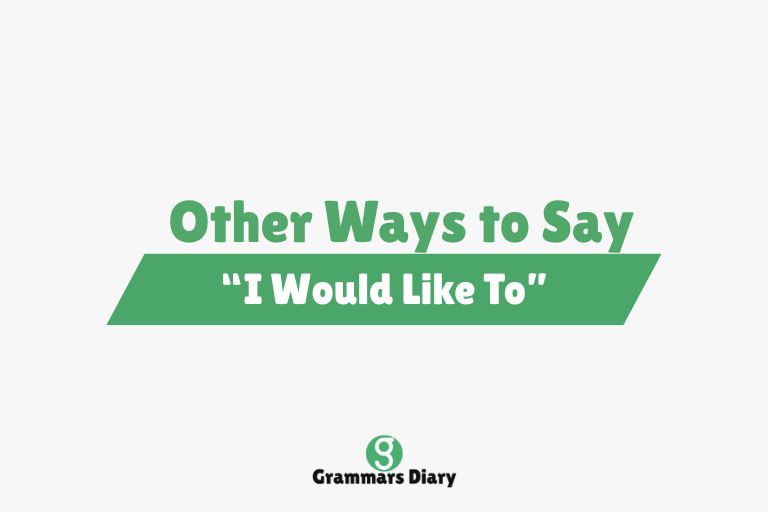“I would like to” is a common and polite expression used to indicate your desires, intentions, or preferences in both formal and informal settings. For instance, when someone says, “I would like to schedule a meeting,” they’re expressing a respectful intent to do something, often inviting cooperation or approval from others involved.
While this phrase is courteous and useful, especially in written and spoken communication, it can feel repetitive or overly formal if used too often. Fortunately, the English language offers many alternatives that can suit different tones, contexts, and purposes. In this article, we’ll walk through 21 powerful and expressive ways to say “I would like to,” helping you vary your vocabulary while preserving the meaning and tone that best suits your communication goals.
Other Ways to Say “I Would Like To”
1. I’m interested in
Example: “I’m interested in learning more about this opportunity.”
Meaning: This expresses a desire or curiosity in a specific topic or activity. It’s warm and open-ended.
Usage: Suitable in both professional and casual situations where you’re showing enthusiasm without being too direct.
2. I’m keen to
Example: “I’m keen to join the team on this new project.”
Meaning: Suggests eagerness and positive anticipation.
Usage: Frequently used in British English, especially in work or academic environments where politeness is valued.
3. I’m eager to
Example: “I’m eager to start working on the new assignment.”
Meaning: Shows active enthusiasm or readiness.
Usage: Perfect when you want to highlight motivation or promptness.
4. I wish to
Example: “I wish to address the following concerns.”
Meaning: A formal expression of desire or intent, often used in writing.
Usage: Common in formal business, legal, or academic correspondence.
5. I hope to
Example: “I hope to contribute to the success of the team.”
Meaning: Reflects both desire and a positive outlook on the possibility of doing something.
Usage: Works well in cover letters, interviews, or polite conversations.
6. I’m planning to
Example: “I’m planning to take the course next semester.”
Meaning: Indicates preparation or intent based on a decision that’s likely to happen.
Usage: Suitable for casual or semi-formal use when explaining your future actions.
7. I’m thinking of
Example: “I’m thinking of taking a short break.”
Meaning: Suggests an idea or desire that’s under consideration but not yet certain.
Usage: Ideal for relaxed conversations or when floating ideas.
8. I’d be happy to
Example: “I’d be happy to help you with that.”
Meaning: Shows willingness and friendliness along with the desire.
Usage: Great for customer service, team interactions, and professional collaboration.
9. I’d prefer to
Example: “I’d prefer to work remotely on Fridays.”
Meaning: Politely expresses a personal choice or priority.
Usage: Useful when negotiating or stating preferences diplomatically.
10. I’m inclined to
Example: “I’m inclined to agree with your perspective.”
Meaning: Suggests a natural or thoughtful tendency toward a decision or action.
Usage: Often used in reflective or respectful discussions.
11. I’m leaning toward
Example: “I’m leaning toward accepting their offer.”
Meaning: Implies a gentle or tentative preference.
Usage: Works well in situations where you’re not fully committed but want to show your direction.
12. I’d love to
Example: “I’d love to visit your office sometime.”
Meaning: A warm, enthusiastic way to express desire.
Usage: Informal but engaging, ideal for friendly or enthusiastic conversations.
13. I intend to
Example: “I intend to complete the project by the end of the week.”
Meaning: A strong and deliberate expression of purpose.
Usage: Suitable for clear and direct communication, especially in goal setting.
14. I aim to
Example: “I aim to improve our response times by 20%.”
Meaning: Demonstrates purpose and objective in a results-driven context.
Usage: Frequently used in corporate or strategic discussions.
15. I’m open to
Example: “I’m open to discussing alternative approaches.”
Meaning: Shows a willingness or receptiveness to an idea or opportunity, while still expressing interest.
Usage: Useful in collaborative environments where flexibility is important.
16. I’d be interested in
Example: “I’d be interested in hearing more about the proposal.”
Meaning: Communicates polite curiosity or engagement with a subject or option.
Usage: Appropriate in professional emails, interviews, or networking conversations.
17. I have a desire to
Example: “I have a desire to pursue further education in this field.”
Meaning: A formal way of stating personal ambition or wish.
Usage: Often used in motivational writing or long-term planning statements.
18. I’d be glad to
Example: “I’d be glad to walk you through the process.”
Meaning: Highlights both willingness and pleasure in offering help or taking an action.
Usage: Friendly and courteous, ideal for customer relations and team support.
19. I feel like
Example: “I feel like taking a short break.”
Meaning: Informally expresses a current inclination or mood.
Usage: Common in everyday conversations, especially when casually expressing a desire or whim.
20. I want to
Example: “I want to make a positive difference.”
Meaning: A direct and assertive way to express intention or desire.
Usage: Can be powerful and sincere but may sound too strong in formal settings unless carefully phrased.
21. I’m considering
Example: “I’m considering applying for a new position.”
Meaning: Indicates thought and reflection about a potential action, without making a firm commitment.
Usage: Ideal when you’re still weighing your options and want to keep communication open-ended.
In Professional Settings
When navigating professional environments, it’s crucial to balance clarity, respect, and authority. Phrases like “I intend to,” “I’m planning to,” or “I’d be happy to” allow you to express intent with confidence and cooperation. These alternatives are particularly effective in meetings, project planning, or formal email correspondence, where tone and precision matter.
In Everyday Conversations
In casual conversations, it’s often better to choose expressions that sound natural and relaxed. Sayings like “I feel like,” “I’d love to,” or “I’m thinking of” make interactions sound friendly and approachable, while still expressing your wishes or ideas clearly. These variations help prevent repetition and keep communication engaging and genuine.
In Academic or Formal Writing
In academic contexts or formal reports, choosing refined language is important. Terms like “I wish to,” “I aim to,” or “I have a desire to” provide a polished tone that communicates thoughtfulness and intent. These expressions signal professionalism and care, especially when outlining goals, presenting arguments, or describing future research directions.
Conclusion
While “I would like to” is a perfectly polite and clear expression, using it too frequently can make your communication sound repetitive or overly formal. Expanding your vocabulary with alternatives such as “I’m eager to,” “I aim to,” or “I’d be happy to” allows you to match tone and intention to the situation, helping you sound more natural, confident, and context-appropriate.
Whether you’re writing a cover letter, chatting with friends, or making plans, these alternatives give you the flexibility to express your desires in a variety of ways. The next time you’re tempted to say “I would like to,” reach for one of these substitutes to add color and precision to your speech or writing.
FAQs
What does “I would like to” mean?
“I would like to” is a polite and formal way to express your interest in doing something or to state a preference. It is often used to show respect or to sound more courteous than simply saying “I want to.”
Is “I would like to” too formal for everyday use?
No, it’s not too formal, but in casual settings, it may come off as overly polite or stiff. In these cases, simpler alternatives like “I want to” or “I’m thinking of” can sound more natural and relaxed.
Can I use “I’d love to” in professional settings?
Yes, “I’d love to” can be used in professional settings if the tone is friendly and informal—such as during team collaborations or client interactions—but it might not be suitable for very formal documents or communications.
What’s the difference between “I intend to” and “I hope to”?
“I intend to” indicates a firm and clear plan to do something, while “I hope to” expresses a desire or wish that something will happen, even if it’s not certain. The former sounds more decisive, while the latter leaves room for uncertainty.
Which alternative sounds most confident?
Expressions like “I intend to,” “I aim to,” and “I’m eager to” project a strong sense of purpose and motivation, making them ideal when you want to sound confident and goal-oriented.











